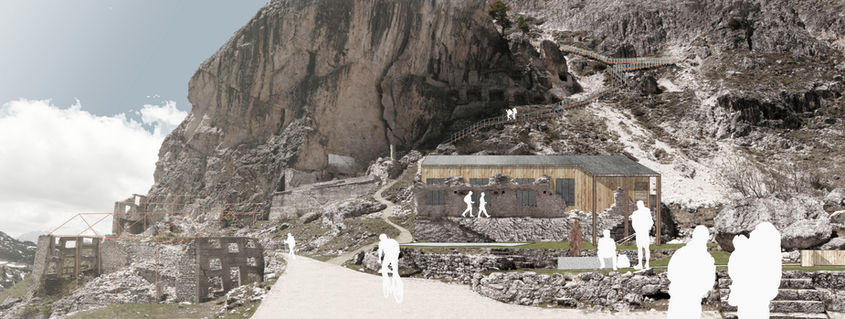Mountain shelter in 'Ospitaletto' in Falzarego pass
Cortina D'Ampezzo, ITALY
As with many other temporary military settlements built due to the war on the slopes of the mountains around Cortina, in the last days of October 1917 the village was abandoned. In the hasty retreat the orders were to blow up ammunition dumps and cut bridges, there was no time to recover and carry heavy weapons and materials so laboriously transported to those heights. It is possible that the dismantling and recovery of the wood and iron parts began with the Austrian reoccupation between November '17 and October 1918.It is assumed, however, that the almost total destruction of the buildings, above all for the recovery of ferrous materials, was more probably the work of the "recovering" companies, adequately equipped, of which there is certain news for example in the case of dismantling of the armor and poutrelle in the near Forte Tre Sassi at Passo di Valparola (1936).
Settlements in Ospitaletto and small Church
This site expresses one of the strongest and protagonist concepts of this conflict, the relationship between man, nature and a hostile landscape. The walls in front, now a popular destination for climbers, represented fear and fear among soldiers due to natural hazards (such as landslides and landslides). However the same walls worked as an element of protection and cover from enemy attacks.Here the perception of the place is often conflicting within the visitor. The ruins present show can not lead us back to one of the most bloody events in history, but at the same time we cannot but appreciate the landscape and the beauty that surrounds us. From here it is possible to perceive the whole valley towards the Cinque Torri, Vervei and Cortina, moreover if you climb on the rock tooth it is placed between the site and the Piccolo Lagazuoi you get a view of the whole valley (from Cortina to Passo Falzarego ). Within the network of interventions, here the path expands creating new spaces with informative seats and landmarks, in front of the ruins, to then fit into one of these, building a corten, steel and wood mountain shelter that can act as a structure to put in safety the walls (now unstable) and give the opportunity to the users to sleep and stay in this place rich in memory so as to be able to appreciate the historical and at the same time the landscape aspect. Finally, through a branching of these spaces we want to create a metallic staircase and some "gates" to connect the highest point of the rock tooth to the west (now hardly accessible). From here it will then be possible to continue towards the Falzarego Pass and the Great War open air Museum on the Piccolo Lagazuoi.






